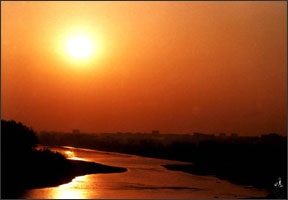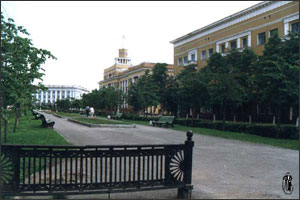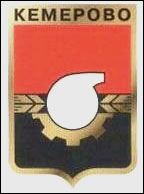
Kemerovo is the administrative, industrial, cultural and educational center of Kuzbass. It was founded in 1918. Its population is more than 500 thousand people. One can say that our city is not ancient but rather young. The city is located in the middle of the Tom River Basin in the Kuznetsk hollow. The centre is located on the left bank of the river Tom. It used to be a picturesque river but unfortunately it is polluted greatly now.
The city consists of 5 districts (Tsentralnyi, Leninskii, Zavodskii, Kirovskii, Rudnichnyi) and 5 working settlements.
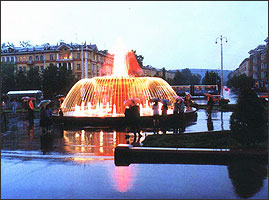 Kemerovo sprang up on the place of ancient Russian settlements. In 1859 there were 7 villages on the territory of today's Kemerovo. One of them was Scheglovo. In 1703 there were only six houses in Scheglovo. It was near this village where Mikhailo Volkov discovered the black coal deposit on the right bank of the Tom River. In the middle of the 19th century the peasants from the neighbouring Kemerovo village tried to extract coal and transport it on rafts to the city of Tomsk, but the management of the Altay mining district forbade doing that. And only in 1907 after the Siberian railway was built the management of the Altay mining district established the Kemerovo mine that was designed to produce 8300 tons of coal per year. In 1915 the construction of a coking plant and chemical shops began near Scheglovo village. In the same year the railway traffic was put into operation. The area of 6 villages Scheglovo, Kemerovo, Krasnyi Yar, Pleshki, Kur-Iskitim, Borovaya became an important industrial center. 1918 is considered to be the year of the city foundation, when Scheglovo was transformed into the city of Scheglovsk (Kemerovo village was included in).
Kemerovo sprang up on the place of ancient Russian settlements. In 1859 there were 7 villages on the territory of today's Kemerovo. One of them was Scheglovo. In 1703 there were only six houses in Scheglovo. It was near this village where Mikhailo Volkov discovered the black coal deposit on the right bank of the Tom River. In the middle of the 19th century the peasants from the neighbouring Kemerovo village tried to extract coal and transport it on rafts to the city of Tomsk, but the management of the Altay mining district forbade doing that. And only in 1907 after the Siberian railway was built the management of the Altay mining district established the Kemerovo mine that was designed to produce 8300 tons of coal per year. In 1915 the construction of a coking plant and chemical shops began near Scheglovo village. In the same year the railway traffic was put into operation. The area of 6 villages Scheglovo, Kemerovo, Krasnyi Yar, Pleshki, Kur-Iskitim, Borovaya became an important industrial center. 1918 is considered to be the year of the city foundation, when Scheglovo was transformed into the city of Scheglovsk (Kemerovo village was included in).
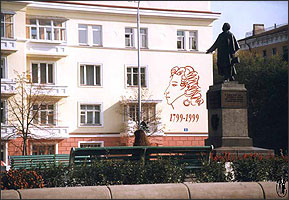 In 1925 the city became the center of the district. There were 2510 wooden houses and 9 schools in the city. The population was 21,7 thousand people. The rapid development of the city was caused by the industrialization and the construction of the Ural-Kuznetskii industrial complex. On March 27, 1932 Scheglovsk was renamed into Kemerovo.
In 1925 the city became the center of the district. There were 2510 wooden houses and 9 schools in the city. The population was 21,7 thousand people. The rapid development of the city was caused by the industrialization and the construction of the Ural-Kuznetskii industrial complex. On March 27, 1932 Scheglovsk was renamed into Kemerovo.
When the Great Patriotic War began, thousands of townspeople went to the front line and bravely battled against fascist aggressors. More than 6000 people of Kemerovo were awarded with battle orders and medals.
On January 26, 1943 Kemerovo was declared as the administrative center of the newly formed Kemerovo Region. By that time the city has become a large industrial center and a leader of the defense industry: 33 factories were evacuated here from the western part of the country.
Today Kemerovo is an administrative center of the Kemerovo Region; it is a city with developed industrial, cultural and scientific potential, economically connected with all the regions of the CIS and foreign countries. It is the second largest city of Kuzbass (after Novokuznetsk).
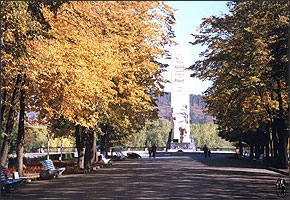 The industry of the city is characterized by a high level of production concentration. The specialization of the city as a center of chemical and fuel-energy industries remains nowadays. The chemical industry is the basis of the economy. It makes 35% of the total output. «Azot», «Khimprom», «Khimvolokno», «Polymer» are the largest chemical enterprises, producing goods competitive in the world markets. Black metallurgy is represented by a coke producing plant «Koks».
The industry of the city is characterized by a high level of production concentration. The specialization of the city as a center of chemical and fuel-energy industries remains nowadays. The chemical industry is the basis of the economy. It makes 35% of the total output. «Azot», «Khimprom», «Khimvolokno», «Polymer» are the largest chemical enterprises, producing goods competitive in the world markets. Black metallurgy is represented by a coke producing plant «Koks».
The coal mining industry is represented by Kedrovskii Open-pit Mine that extracts high-quality coals. The power complex comprises three large heat-electric generating stations. The mechanical engineering of the city includes 23 large and average enterprises. The leading enterprises are «Khimmash», «Stromautomash», «ZETA» and «KZEMI».
Food processing enterprises (flour, cereals, milk, meat and confectionery), enterprises of light industry and mechanical engineering (equipment for coal mining and chemical industry), construction industry enterprises (wood processing, production of building materials) are developing.
The city now is a large trading center with the advanced infrastructure of the consumer market and entrepreneurship.
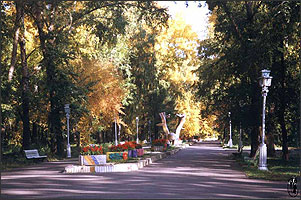 Kemerovites and guests of the city like to walk along the embankment of the Tom river. One can see there the bridges across the river, the Monument of Glory dedicated to the soldiers of the Great Patriotic War. In front of the Monument there is the Alley of Heroes. Some lime-trees were planted by cosmonauts: Alexey Leonov, Boris Volynov and the frontier guard Yuri Babansky. If you want to do sightseeing, you can see the Drama theatre (with the beautiful singing fountain in front of its facade), the Puppet theatre, the Musical Comedy theatre, art galleries, exhibitions and museums. The halls of the city regional museum and the museum of fine arts are always full of visitors. The reserve-museum Tomskaya Pisanitsa located on the right bank of the Tom River (55 kilometers away from the city) is very popular with the townspeople and guests of the city. Unique historical monuments are concentrated here in the open-air; the oldest of them date back to the fourth millennium B.C.
Kemerovites and guests of the city like to walk along the embankment of the Tom river. One can see there the bridges across the river, the Monument of Glory dedicated to the soldiers of the Great Patriotic War. In front of the Monument there is the Alley of Heroes. Some lime-trees were planted by cosmonauts: Alexey Leonov, Boris Volynov and the frontier guard Yuri Babansky. If you want to do sightseeing, you can see the Drama theatre (with the beautiful singing fountain in front of its facade), the Puppet theatre, the Musical Comedy theatre, art galleries, exhibitions and museums. The halls of the city regional museum and the museum of fine arts are always full of visitors. The reserve-museum Tomskaya Pisanitsa located on the right bank of the Tom River (55 kilometers away from the city) is very popular with the townspeople and guests of the city. Unique historical monuments are concentrated here in the open-air; the oldest of them date back to the fourth millennium B.C.
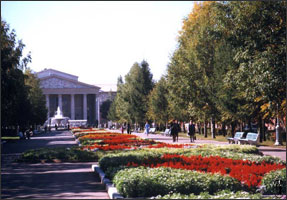 The first square in our city was Pushkin Square, but the monument to the poet was set up in 1949. Not far from the square there is the most beautiful street of the city — Vesennyaya Street. Together with Central City Park it is the greenest place in Kemerovo. Kemerovites are also proud of their pine wood on the right bank of the Tom river. Across the Iskitimka river one can see the magnificent
The first square in our city was Pushkin Square, but the monument to the poet was set up in 1949. Not far from the square there is the most beautiful street of the city — Vesennyaya Street. Together with Central City Park it is the greenest place in Kemerovo. Kemerovites are also proud of their pine wood on the right bank of the Tom river. Across the Iskitimka river one can see the magnificent 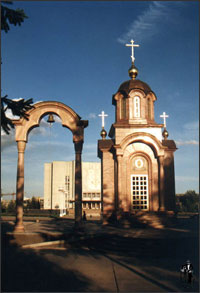 building of the Kemerovo Circus built in 1973. It houses 2000 people. The streets in Kemerovo are broad and straight. The street traffic is rather heavy in the main thoroughfares, which connect all parts of the town. The longest are Sovetsky, Oktjabrsky and Lenin prospects.
building of the Kemerovo Circus built in 1973. It houses 2000 people. The streets in Kemerovo are broad and straight. The street traffic is rather heavy in the main thoroughfares, which connect all parts of the town. The longest are Sovetsky, Oktjabrsky and Lenin prospects.
Kemerovo is one of the largest Siberian educational centers. Thousands of students are trained at 13 higher educational institutions and 17 technical schools. Among the best-known higher schools are Kemerovo State University (it has branches in Novokuznetsk, Belovo, Anzhero-Sudjensk, Prokopyevsk), Kuzbass State Technical University (it has branches in Belovo, Anzhero-Sudjensk, Prokopyevsk, Mezhdurechensk, Novokuznetsk, Tashtagol), Kemerovo Technological Institute of the Food Industry and others. Kemerovo is a city of science. Two thirds of all Kuzbass research Institutes are found here.
The residents of Kemerovo are proud of the noble townspeople: Honorable Citizens of the City Alexey Leonov, cosmonaut, two-time Hero of the Soviet Union; Michail Podgorbunskii, honored doctor of RSFSR; Dmitriy Plotnikov, Hero of Socialist Labor; Polina Krivova, honored teacher; Nicholay Vdovin, Hero of Socialist Labor; Vitaliy Razdaev, master of sports, Galina Zavadskaya, honored doctor of RSFSR; and Vasiliy Selivanov, artist.
